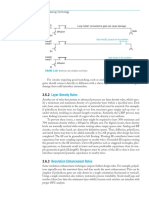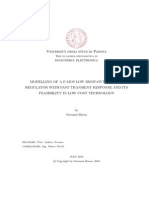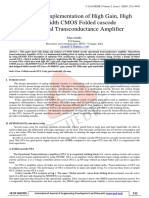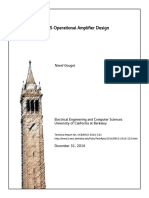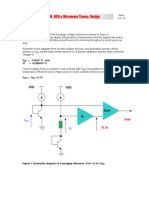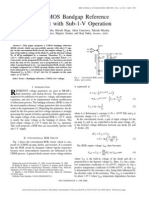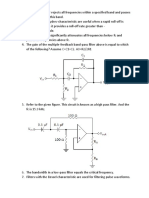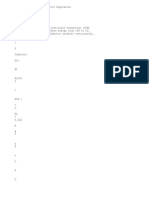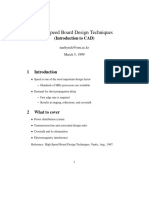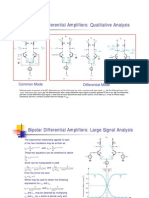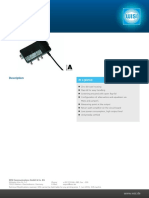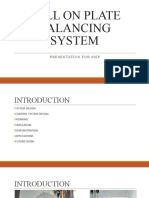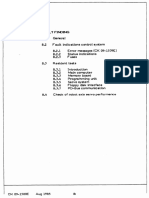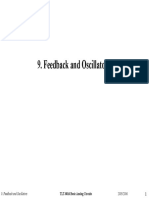7418.LDO PSRR Analysis Rincon Mora
7418.LDO PSRR Analysis Rincon Mora
Uploaded by
rivercamCopyright:
Available Formats
7418.LDO PSRR Analysis Rincon Mora
7418.LDO PSRR Analysis Rincon Mora
Uploaded by
rivercamCopyright
Available Formats
Share this document
Did you find this document useful?
Is this content inappropriate?
Copyright:
Available Formats
7418.LDO PSRR Analysis Rincon Mora
7418.LDO PSRR Analysis Rincon Mora
Uploaded by
rivercamCopyright:
Available Formats
C
o-A
V
dd
V
out-A
V
out
V
ref
C
out
R
1
R
2
I
load
PASS
DEVICE
ERROR
AMPLIFIER
R
o-A
G
m-A
ABSTRACT
Linear regulators are critical analog blocks that shield a
system from fluctuations in supply rails and the importance of
determining their Power Supply Rejection (PSR) performance is
magnified in SoC systems, given their inherently noisy
environments. In this work, a simple, intuitive, voltage divider
model is introduced to analyze the PSR of linear regulators,
from which design guidelines for obtaining high PSR
performance are derived. The PSR of regulators that use PMOS
output stages for low drop-out (LDO), crucial for modern low-
voltage systems, is enhanced by error amplifiers which present a
supply-correlated ripple at the gate of the PMOS pass device.
On the other hand, amplifiers that suppress the supply ripple at
their output are optimal for NMOS output stages since the
source is now free from output ripple. A better PSR bandwidth,
at the cost of dc PSR, can be obtained by interchanging the
amplifiers in the two cases. It has also been proved that the dc
PSR, its dominant frequency breakpoint (where performance
starts to degrade), and three subsequent breakpoints are
determined by the dc open-loop gain, error amplifier bandwidth,
unity-gain frequency (UGF) of the system, output pole, and
ESR zero, respectively. These results were verified with SPICE
simulations using BSIM3 models for the TSMC 0.35 m CMOS
process from MOSIS.
I. INTRODUCTION
The close proximity of analog and digital circuits in SoC
environments can cause them to be overwhelmed by spurious
switching noise signals propagated through supply lines,
interface nodes, and substrate injection [1], [2]. In these VLSI
and ULSI circuits, voltage regulators form an indispensable
component of the power management system. They generate
stable voltages while supplying a wide range of currents to a
variety of circuits. They also filter the fluctuations in the power
supply, thereby shielding their load circuits from supply ripple.
Thus, in circuits like DRAMs [3], PLLs [4], [5], and EPROMs
[6], where power supply noise directly translates to degradation
in system performance, power supply rejection is a key figure of
merit for a voltage regulator. It is therefore imperative to
analyze the PSR of linear regulators over a large frequency
range with the aim of establishing design guidelines and
principles for high PSR performance. Further, as systems
aggressively advance towards integration, these state-of-the-art
regulators rely increasingly on on-chip capacitors (10-200 pF)
for frequency compensation [3]-[7]. These capacitors do not
consume expensive board-space and are not associated with a
significant equivalent series resistance (ESR). Since the
regulators do not use an external capacitor to establish the
dominant low-frequency pole, they are termed internally
compensated regulators. It must be noted, however, that the
effects of ESR still warrant discussion, since they become
important when the connectivity to the plates of the capacitor is
limited by the dense routing requirements of the chip.
II. PSR OF A TYPICAL LINEAR REGULATOR
Fig. 1. Block diagram of typical linear regulator (pass device may be
PMOS or NMOS).
Fig. 1 depicts the block diagram of a typical regulator
consisting of an error amplifier, a pass device and an output
capacitor, C
out
[3]-[10]. The regulator supplies a variable current
to the load circuit through the pass device while maintaining a
constant output voltage due to a feedback loop formed by the
potential divider created by resistors R
1
and R
2
( = R
2
/(R
1
+R
2
))
and the amplifier. The amplifier is characterized by its
transconductance G
m-A
, high output resistance, R
o-A
(R
o-A
1/G
o-A
), and corresponding pole, p
o-A
(f
p-oA
1/2R
o-A
C
o-A
). The
large series pass device (NMOS or PMOS) has a
transconductance g
m
and low drain-source resistance r
ds
(r
ds
1/g
ds
). Bias resistors, R
1
and R
2
, that form the feedback network
through a potential divider, are typically very large (R
1
+R
2
>>
r
ds
= 1/I
load
) for low quiescent power consumption. Though this
model is a very accurate representation of a linear regulator, it
does not offer an intuitive picture into the origin of the PSR
frequency response a measure of the supply ripple transferred
to the output.
A. Simple Model for PSR of Linear Regulators
In its simplest form, the PSR transfer function (a ratio of the
output to the supply ripple) can be viewed as the effect of a
voltage divider caused by an impedance between the supply and
the regulator output and an impedance between the output and
ground. An intuitive and insightful model for analyzing the PSR
of a typical linear regulator is presented in Fig. 2. This model
consists of an impedance ladder comprising of the channel
resistance of the pass device (r
ds
), and a parallel combination of
the open-loop output resistance to ground (z
o
) and the shunting
effect of the feedback loop (z
o-reg
). Hence, referring to Fig. 1 and
Fig. 2, we can see that
( ) ( )
R R
||
R z z 2 1 ESR Cout o
+ + = , (1)
and,
Analysis and Design of Monolithic, High PSR, Linear Regulators for SoC Applications
Vishal Gupta
1
, Student Member, IEEE, Gabriel A. Rincn-Mora
1
, Senior Member, IEEE, and Prasun Raha
2
,
Member, IEEE
Email: vishalg@ece.gatech.edu
1
Georgia Tech Analog and Power IC Design Lab, Georgia Institute of Technology,
2
Texas Instruments Inc.
A
r
||
z
z
ol
ds o
reg o
. (2)
The model is presented in Fig. 2. Thus, by simplifying the
model in Fig. 1 to the one in Fig. 2, the PSR can be seen to be
)
z
||
z
(
r
)
z
||
z
(
v
v
PSR
reg o o ds
reg o o
dd
out
+
= = . (3)
z
o-reg
v
out
z
o
v
dd
r
ds
)
z
||
z
(
r
)
z
||
z
(
v
v
PSR
reg o o ds
reg o o
dd
out
+
= =
( ) ( )
R R
||
R z z 2 1 ESR Cout o
+ + =
A
r
||
z
z
ol
ds o
reg o
Effective when loop gain
low (moderate to high
frequencies)
Effective when loop gain
high (low to moderate
frequencies)
Fig. 2. Intuitive model for PSR in action at various frequencies.
B. Model in Action over Wide Frequency Range
Fig. 3 depicts the sketch of a typical PSR curve and how the
intuitive model allows us to determine the PSR performance of
a linear regulator over a large range of frequencies, simply by
accounting for the frequency dependence of z
o
and z
o-reg
.
r
ds
R
o-reg
v
out
r
ds
z
o-reg
v
out
v
dd
v
dd
r
ds
R
1
+R
2
v
out
v
dd
r
ds
R
1
+R
2
v
out
v
dd
C
out
r
ds
v
out
v
dd
C
out
R
ESR
r
ds
v
out
v
dd
R
ESR
P
S
R
=
v
o
u
t /
v
in
[
d
B
]
Frequency [Hz]
PSR
dc
=(A
ol
)
1
z
1
=BW
A
p
1
=UGF
p
2
=p
out
z
2
=1/2R
ESR
C
out
If ESR
negligible
HIGH LOW MODERATE
Fig. 3. Simple model in action over wide frequency range.
1) DC and Low Frequencies
At low frequencies, the high loop gain (A
ol-dc
) allows z
o-reg
to shunt z
o
, and since r
ds
is, for the most part, significantly lower
than R
1
+R
2
, the following simplification can be derived:
( )
( )
+
+
+
=
+
A
1
A
r
r
A
r
A
R R
||
r
r
A
R R
||
r
R r
R
PSR
dc ol
dc ol
ds
ds
dc ol
ds
dc ol
2 1 ds
ds
dc ol
2 1 ds
reg o ds
reg o
dc
.
(4)
Consequently, the PSR of the regulator is intimately related to
the open-loop gain of the system.
2) Moderate Frequencies
The shunting effect of the feedback loop, however,
deteriorates at frequencies beyond the bandwidth of the
amplifier, BW
A
(or dominant pole, p
o-A
), thereby causing an
increase in the regulated output impedance, z
o-reg
. This leads to a
rise in the output ripple and, consequently, the dominant PSR
breakpoint in the form of a PSR zero (z
1
). The resultant
degradation in the PSR can been obtained by replacing A
ol-dc
in
(4) with the bandwidth-limited response of the loop at
frequencies where A
ol-dc
is greater than one i.e. between dc and
the unity-gain frequency (UGF) of the system. This leads to
r r
p
s
1
A
r
r r
)
A
(
r
z r
z
| PSR
ds ds
A o
dc ol
ds
ds ds ol
ds
reg o ds
reg o
UGF f
+
+
=
+
=
+
( ) |
.
|
\
|
+
+
+
+ +
+
=
UGF
s
1
A
BW
s
1
p )
A
1 (
s
1 )
A
1 (
p
s
1
dc ol
A
A o dc ol
dc ol
A o
. (5)
The presence of a PSR pole (p
1
) at the unity-gain frequency,
as predicted by (5), can be easily understood when we note that
the deterioration of the PSR due to increasing closed-loop
output resistance ceases at the UGF. At this stage, the shunting
effect of the feedback loop no longer exists and the PSR is
determined simply by the frequency-independent resistive
divider between the channel resistance of the pass device (r
ds
)
and bias resistors (R
1
+R
2
). The PSR is given by
1
r R R
R R
r z
z
| PSR
ds 2 1
2 1
ds o
o
UGF f
+ +
+
=
+
=
. (6)
At these frequencies, the PSR of the system is the weakest since
the closed loop output resistance is not decreased by the
feedback loop and the output capacitor cannot shunt the output
ripple to ground.
3) High Frequencies
When the output capacitor starts shunting (R
1
+R
2
) to ground,
a smaller ripple appears at the output, thereby causing an
improvement in the PSR (since z
o
decreases with increasing
frequency) and the second PSR pole (p
2
). Thus,
r z
z
r z
z
| PSR
ds Cout
Cout
ds o
o
UGF f
+
=
+
>
. (7)
The effectiveness of the output capacitor is, however, restricted
by its ESR. At very high frequencies, since this capacitor is an
ac short, z
o
is determined by the ESR, which limits PSR to
r R
R
r z
z
| PSR
ds ESR
ESR
ds o
o
UGF f
+
>>
, (8)
thereby leading to the formation of an effective PSR zero at z
2
=
1/2R
ESR
C
out
. Fig. 3 shows a sketch of the poles and zeros of a
typical PSR curve predicted by this model.
Though the simple model depicted in Fig. 2 provides an
intuitive understanding of the relationship between PSR and the
open-loop gain of the regulator, it does not take into account the
effect of the conduction of the supply ripple through the
amplifier itself. This ripple feedthrough has significant
implications for high PSR design and is critical for determining
the optimal amplifier topology for a particular type of output
stage. Before analyzing the PSR of the error amplifier, let us
discuss the mechanism of ripple conduction through the output
stage, or series pass device of the regulator. Then, the design of
the amplifier will be considered.
III. DESIGNING FOR HIGH PSR
A. Series Pass Device
In applications where low drop-out is not a primary concern,
the output stage of the regulator is often an NMOS device.
Despite the relatively large voltage headroom required to drive
the gate due to its gate-source voltage drop, the NMOS device,
acting as a source follower, offers an inherently low output
impedance, making the compensation of the regulator easier
than its low drop-out counterpart [6], [7]. It is evident that in
this follower configuration, the NMOS device will conduct the
ripple present at its gate directly to its output, the source. Hence,
to keep the ripple at the output node low, it is crucial to design
the preceding error amplifier such that the ripple at the gate of
the NMOS device is as small as possible.
In most low voltage applications today, however, a PFET
transistor is used as the output series pass device [8]-[10]
because of the driving requirements of its gate. In this
configuration, the gain from the source of the device (connected
to V
dd
) to its drain, has the same magnitude as the gain from its
gate to its drain, i.e., g
m
r
ds
. However, the two gain paths are out
of phase. Hence, in order to cancel the feedthrough of the power
supply ripple from the source, the preceding amplifier should
provide a correlated ripple at the gate of the PMOS device (V
SG
= V
S
V
G
=
Vdd
Vdd
= 0). In other words, the supply ripple
should appear as a common-mode signal at the gate and the
source.
B. PSR of the Error Amplifier
Most error amplifiers that have a single-ended output use a
current-mirror load to perform double-to-single-ended
conversion and add the ac signals obtained from the input
differential pair to a single-ended signal. This mirror may be
implemented in the form of PMOS devices connected to the
supply or NMOS devices connected to ground [11]. Let us
classify the former PMOS-mirror topologies as Type-A
topologies, and the latter as Type-B. In the following analysis, it
will become apparent that the implementation of the current-
mirror is critical in determining the PSR of the error amplifier,
and therefore the regulator. In this analysis, v
dd
and v
out-A
are the
ac ripples at the supply and the output of the amplifier,
respectively. The internal capacitances of the amplifiers have
been ignored for simplicity and since they are negligible when
compared to the high device capacitances of the large output
power device. The analysis also assumes that transconductance
of all the devices (g
m
) is much greater than their channel
conductance (g
ds
), which is typical in analog IC design (channel
lengths are larger than the minimum).
1) Type-A Topologies
Consider a typical example of the Type-A architecture,
namely, the conventional error amplifier as shown in Fig. 4(b),
which consists of an NMOS input differential pair and a PMOS
current-mirror load connected to the supply. The small signal
PSR model of this circuit is presented in Fig. 4(a). The model is
obtained by grounding the two inputs to the amplifier and
applying a small signal source at the input supply (v
dd
). R
1
and
R
2
represent the channel resistances of the PMOS and NMOS
devices, respectively. The current-dependent current source
(i
R2
), which reflects the current flowing through resistor R
2
into
the output, models the effect of the current mirror. Assuming
the 1/g
m
resistance (of the diode-connected PMOS device) is
much smaller when compared against R
2
, which is typically the
case, the supply ripple is entirely reflected at the output,
( )
R
||
R i
R R
R
v v 2 1 2 R
2 1
2
dd A out
+
|
|
.
|
\
|
+
=
v
R R
R R
R
v
R R
R
v dd
2 1
2 1
2
dd
2 1
2
dd
=
|
|
.
|
\
|
+
+
|
|
.
|
\
|
+
. (9)
A similar result is reported in [2], where it was found that, for
this amplifier topology, the entire supply ripple was transferred
to the output over a wide frequency range.
Fig. 4. (a) Small signal model for PSR of Type A error amplifiers, (b),
(c), and (d) Examples of Type A error amplifiers.
Figs. 4(c) and 4(d) present two other examples of Type-A
structures of the folded type with PMOS current-mirror loads.
Noting that the signals at v
x
and v
y
are both common-mode with
respect to the differential pair, they cancel out and the effect
of the input differential pair is therefore nullified. Hence, the
small signal PSR models of these error amplifiers corresponds
to the same model presented in Fig. 4(a), which was analyzed
earlier and described with (9). The devices represented by
resistors R
1
and R
2
are depicted in dashed boxes in Figs. 4(b)-
(d). Thus, from Fig. 4 and (9), it can be established that the
supply ripple appears at the output unattenuated for Type-A
topologies.
2) Type-B Topologies
Fig. 5(b) illustrates a conventional error amplifier consisting
of a PMOS differential input pair and an NMOS current-mirror
load connected to ground. This is a typical example of a Type-B
topology. As in the model for Type-A topologies discussed
earlier, the small signal PSR model of this circuit can be
constructed by grounding the inputs, neglecting the (1/g
m
)
resistance of the diode-connected NMOS device (when
compared against the channel resistance of the PMOS device),
and modeling the current-mirror as a current-dependent current
source connected between the output and ground. This model is
presented in Fig. 5(a). The derivation of the transfer-function
v
out-A
/v
dd
reveals that no ac ripple appears at the output,
theoretically isolating the output from the input supply ripple,
MP1 MP2
V+ V-
v
out-A
BIAS
MP4 MP3
MC1
MC2
v
out-A
BIAS
MN1 MN2
MP1 MP2
MC1
MC2
V+ V-
Vdd
Vdd
MP1 MP2
MN1 MN2
v
out-A
Vdd
V+ V-
R
1
R
2
R
2
R
2
R
2
R
1
R
2
R
2
R
1
v
x
v
y
v
x
v
y
(c) (d)
(b)
Vdd
(a)
v
dd
i
R2
i
R2
v
out-A
R
2
R
1
R
2
1/g
m
g G g G
)
C
)
G g g ( )
C C
(
G
( s
C C s
g G C
)
G g ( s
v
v
PSR
ds
A o
m
A m
'
gd A m
m ds
'
gd out A o
'
gd out
2
ds
A o
'
gd A o
m
dd
out
+ + + + + +
+ +
= (11)
V
out
(1.2V)
C
out
(100pF)
V
dd
MP1 (10/1) MP2 (10/1)
MN1 (10/1) MN2 (10/1)
MBIAS (10/1)
V
out-A
V
ref
(1.2V)
MOUT (2500/0.35)
R
(30K)
C
m
(25pF)
(10/1)
200uA
( )
R
||
R i
R R
R
v v 2 1 1 R
2 1
2
dd A out
|
|
.
|
\
|
+
=
0
R R
R R
R
v
R R
R
v
2 1
2 1
1
dd
2 1
2
dd
=
|
|
.
|
\
|
+
|
|
.
|
\
|
+
= . (10)
MP1 MP2
MN1 MN2
V+ V-
Vout-A
MP1 MP2 V+ V-
MN1 MN2
MC1
MC2
BIAS
v
out-A
Vdd
Vdd
MN4 MN3
MC1
MC2
MN1 MN2
BIAS
V+ V-
Vdd
v
x
v
y
R
1
R
2
R
1
R
1
R
2
R
1
R
1
R
2
R
1
(c)
(d)
(b)
Vdd
i
R1
R
1
R
1
R
2 i
R1
1/g
m
(a)
v
dd
v
out-A
v
out-A
Fig. 5. (a) Small signal model for PSR of Type A error amplifiers, (b),
(c), and (d) Examples of Type A error amplifiers.
Figs. 5(c) and 5(d) depict two other examples of the Type-B
topology of the folded type using NMOS current-mirror loads.
As in Type-A topologies, on observing that the signals at v
x
and
v
y
are common mode with respect to the input differential pair,
it can be seen that their small signal PSR model corresponds to
the model presented in Fig. 5(a). Hence, from Fig. 5 and (10), it
is evident that Type-B topologies shield their respective outputs
from ripples in the supply.
C. General Design Guidelines for High PSR
Most LDO topologies use a PMOS pass device at the output
because it exhibits a low forward drop (and consequently a low
power loss across the device). Type-A error amplifiers, as it
turns out, conduct nearly the entire ripple at the supply to their
output. Having the ripples at the gate and source equal in
magnitude and phase makes the supply ripple common-mode,
thereby canceling any feedthrough. Type-B amplifiers in source
follower type power devices shield the gate and therefore the
source and output from any supply ripple.
IV. RESULTS FROM SAMPLE DESIGN
The design principles from Sections II and III were used to
design a monolithic low drop-out regulator having the
specifications presented in Table 2. The process technology is
0.35m TSMC CMOS. The output voltage of 1.2V is typical of
many low-voltage applications. Many of these applications, like
EPROMs and DRAMs, do not require large currents and hence
a typical value for the maximum output current of 20mA has
been chosen. Since a completely integrated design is required,
the value of the required capacitance should lend itself easily to
fabrication. Towards this aim, the value of the maximum
allowable total capacitance of 150 pF has been chosen.
TABLE 2. CIRCUIT AND PROCESS PARAMETERS FOR A LOW DROP-OUT
REGULATOR DESIGN.
Circuit
Parameter
Value
Process
Parameter
Value
VDD
3.3 V K
p
65 A/V
2
V
out
1.2 V K
n
185
A/V
2
PSR @ dc -70 dB |V
tp
| 0.74 V
PSR @ 1MHz -20 dB V
tn
0.61 V
Dropout @ I
load
=
20mA
300 mV C
ox
4 fF/m
2
C
out
< 150 pF
n
=
p
0.1
Fig. 6. Schematic of LDO using PMOS output device and conventional
OTA.
The low drop-out voltage specifications necessitated the use of a
PMOS output stage, and hence a Type-A amplifier. For the sake
of simplicity, the conventional amplifier of Fig. 4(b) was
chosen. The schematic of the LDO design is presented in Fig. 6.
The small signal equivalent of the circuit was then analyzed for
PSR, in a manner similar to [11]. Only the large device
capacitances of the output device were considered in the
analysis. If A
dc-A
and G
o-A
are the dc gain and output
conductance of the amplifier, respectively, and C
gd
is the total
gate-drain capacitance, including compensating Miller capacitor
C
m
, the PSR transfer function is given by (11). The dc gain,
zero, and poles of this transfer function are
A
1
A
1
r
g
1
A
1
g
g
g
g
G
G
PSR
dc ol A dc ds
m
A dc
m
ds
m
ds
A m
A o
dc
= = = , (12)
BW p
)
C r
g (
R
1
C g
g G
z A A o '
gd ds A o m
'
gd
m
ds A o
1
= = =
, (13)
UGF
C
G
C
)
G g g ( )
C C
(
G
g G g G
p
'
gd
A m
'
gd A m m ds
'
gd out A o
ds A o m A m
1
=
+ + +
+
, (14)
and
p
C
g
C C
C
)
G g g ( )
C C
(
G
p
out
out
m
'
gd out
'
gd A m m ds
'
gd out A o
2
=
+ + +
, (15)
The assumptions made in the analysis above are that g
m
is much
-80
-70
-60
-50
-40
-30
-20
-10
0
1E+01 1E+03 1E+05 1E+07 1E+09
frequency [Hz]
P
S
R
[
d
B
]
PSR (Sim)
PSR (Anal.)
PSR (Sim. 0pF)
-40
-20
0
20
40
60
80
1E+01 1E+02 1E+03 1E+04 1E+05 1E+06 1E+07 1E+08 1E+09
frequency [Hz]
A
o
l
[
d
B
]
greater than g
ds
for all devices, g
ds
is much greater than G
o-A
,
and g
m
C
gd
is much greater than g
ds
C
gs
, G
o-A
C
out
(due the large
size of he series pass device). These assumptions are reasonable
for a typical low-power regulator using a large series pass
device and large compensating capacitors relative to device
capacitances.
Fig. 7. PSR performance comparison of simulated and analytical results
for PSR for regulator using PMOS pass device (inset shows open loop
gain).
Fig. 7 illustrates both the simulated and the analytical PSR,
along with the simulated open-loop gain of the regulator. The
SPICE simulations, which used BSIM3 models, show a strong
correlation between the open-loop gain and the PSR of the
regulator and agree very well with the analytical results, which
were obtained through MATLAB. Fig. 7 also shows the
simulated PSR in the absence of C
out
the degradation in the
PSR at high frequencies can easily be noted through the absence
of the second PSR pole, p
2
, the output pole.
TABLE 3. ANALYTICAL EXPRESSIONS FOR POLES AND ZEROS OF THE
PSR OF TYPICAL REGULATOR TOPOLOGIES IN TERMS OF THEIR OPEN
LOOP CHARACTERISTICS (P
1
=UGF AND P
2
=P
OUT
FOR ALL TOPOLOGIES)
Pass
Device
Error
amplifier
|PSR|
dc
z
1
High
dc
PSR
High
PSR
BW
Type-A r g R G ds m A o A m
p
o-A
PMOS
Type-B R G A o A m
p r g
A o ds m
Type-A R G A o A m
p r g
A o ds m
NMOS
Type-B r g R G ds m A o A m
p
o-A
Table 3 compares the results of the analysis performed in the
previous section to the results of a similar analysis performed
for regulators consisting of a PMOS output stage with a Type B
Error amplifier and an NMOS output stage with Type A and
Type B amplifiers. It is evident that Type-A (Type-B)
amplifiers provide much higher dc PSRR than their Type-B
(Type-A) counterparts for PMOS (NMOS) devices. Another
way to view this result is as follows: the Type-A amplifier can
meet the dc PSRR specifications of an LDO regulator with a
lower gain than a Type-B topology. This would make the Type-
A amplifier a preferred choice in many CMOS applications,
where low voltage headroom makes the design of high-gain
amplifiers a challenge [8]-[10]. It must be noted, however, that
in applications where a high PSRR bandwidth is required at the
expense of dc PSRR, the Type-B amplifier is a more
suitable choice since its dominant PSRR breakpoint
(zero) lies at a higher frequency (z
1
= p
o-A
g
m
r
ds
) than for
the conventional error amplifier case (z
1
= p
o-A
).
V. CONCLUSIONS
A simple, intuitive voltage divider model for the PSR of a
typical linear regulator is used to accurately describe the PSR
performance of linear regulators. The PSR at low frequencies,
the dominant PSR breakpoint where performance starts to
degrade, and three subsequent breakpoints are determined by
the dc open-loop gain, the error amplifier bandwidth, the unity-
gain frequency, the output pole of the regulator, and the ESR
zero, respectively. A closer examination of the PSR of a
regulator reveals that amplifiers that employ mirrors connected
to supply to produce a supply-correlated ripple at the gate of the
PMOS output device (thereby making the ripple common-
mode) are best suited for LDO applications with high PSR
performance, while amplifiers that use mirrors connected to
ground to attenuate the supply ripple at their output are optimal
for driving an NMOS output stage (since the gate, and hence,
source, is now free from output ripple). A better PSR
bandwidth, at the cost of dc PSR, can be obtained by
interchanging the amplifiers in the two cases. A strong
relationship between the PSR and open-loop gain of a linear
regulator has been established from which design principles
critical to obtaining high PSR performance have been proposed.
REFERENCES
[1] M. S. J, Steyaert, W. M. C. Sansen, Power supply rejection ratio
in operational transconductance amplifiers, IEEE Trans. Circuits
Sys., vol. 37, pp. 1077-1084, Sept. 1990.
[2] E. Sckinger, J. Goette, W. Guggenbl, A general relationship
between amplifier parameters, and its application to PSRR
improvement, IEEE Trans. Circuits Sys., vol. 38, pp. 1173-1181,
Oct. 1991.
[3] H. Tanaka, M. Aoki, T. Sakata, S.Kimura, N. Sakashita, H.
Hidaka, T. Tachibana, and K. Kimura, A precise on-chip voltage
generator for a gigascale DRAM with a negative word-line
scheme, IEEE Jour. of Solid-State Circuits, vol. 34, pp. 1084-
1090, Aug. 1999.
[4] V.R. von Kaenel, A high-speed, low-power clock generator for a
microprocessor application, IEEE Jour. of Solid-State Circuits,
vol. 33, pp.1634-1639, Nov. 1998.
[5] C.Lee, K. McClellan, and J. Choma Jr., A supply-noise-
insensitive CMOS PLL with a voltage regulator using dc-dc
capacitive converter, IEEE Jour. of Solid-State Circuits, vol. 36,
pp. 1453-1463, Oct. 2001.
[6] J. Shor, Y. Sofer, Y. Polansky, and E. Maayan, Low power
voltage regulator for EPROM applications, in Proc. IEEE Intl.
Symp. Circuits and Sys., 2002, pp. 56-579.
[7] G.W. den Besten and B. Nauta, Embedded 5V-to-3.3V voltage
regulator for supplying digital ICs in 3.3V CMOS technology,
IEEE Jour. of Solid-State Circuits, vol. 33, pp. 956-962, July 1998.
[8] V. Balan, A low-voltage regulator circuit with self-bias to
improve accuracy, IEEE Jour. Solid State Circuits, vol. 38, pp.
365-368, Feb. 2003.
[9] S. Yuan, and B. C. Kim, Low dropout voltage regulator for
wireless applications, in 33
rd
IEEE PESC, 2002, pp. 421-424.
[10] H. Shin, S. Reynolds, K. Wrenner, T. Rajeevakumar, and S.
Gowda, Low-dropout on-chip voltage regulator for low-power
circuits, in IEEE Symp. Low Power Electronics, 1994, pp. 76-77.
[11] P.E. Allen and D.R. Holberg, CMOS Analog Circuit Design. New
York, NY: Oxford University Press, 2002.
You might also like
- Low-Dropout Voltage Regulator (LDO)Document30 pagesLow-Dropout Voltage Regulator (LDO)jashvenepally100% (1)
- EE314 Stanford Lectures On RFDocument19 pagesEE314 Stanford Lectures On RFapi-3804019100% (4)
- Data Converter FundamentalsDocument27 pagesData Converter FundamentalstkbattulaNo ratings yet
- Comparator Slides v1 - 0Document44 pagesComparator Slides v1 - 0Preeti BobdeNo ratings yet
- OP Amp OscillatorsDocument5 pagesOP Amp Oscillatorskok6100% (1)
- Lecture17 Fully Diff Amps CMFBDocument28 pagesLecture17 Fully Diff Amps CMFBmohamedNo ratings yet
- EMT 182 Analog Electronic I: Basic Field Effect Transistors AmplifiersDocument34 pagesEMT 182 Analog Electronic I: Basic Field Effect Transistors AmplifiersHaryaniSyafika100% (1)
- IEEE - Cascoded OTA Based LDODocument5 pagesIEEE - Cascoded OTA Based LDORajatNo ratings yet
- Design For A Gate-Driver CircuitDocument27 pagesDesign For A Gate-Driver Circuitdhruv100% (1)
- Aic Lec 12 5t Ota v01Document37 pagesAic Lec 12 5t Ota v01Mustafa NasserNo ratings yet
- Layer Density Rules: Chapter 3 CMOS Processing TechnologyDocument1 pageLayer Density Rules: Chapter 3 CMOS Processing TechnologyCarlos Saavedra100% (1)
- Universit' A Degli Studi Di Padova Ingegneria Elettronica: Tesi Di Laurea Specialistica inDocument119 pagesUniversit' A Degli Studi Di Padova Ingegneria Elettronica: Tesi Di Laurea Specialistica invijith133No ratings yet
- Final Thesis - ADCDocument82 pagesFinal Thesis - ADCTrương Tuấn VũNo ratings yet
- Transistor Active High Pass Filter Electronics NotesDocument2 pagesTransistor Active High Pass Filter Electronics NotesRenato DeákNo ratings yet
- Analysis and Design LDODocument32 pagesAnalysis and Design LDONguyễn ThắngNo ratings yet
- C3.0 Operational Amplifiers II: Jeng-Han TsaiDocument12 pagesC3.0 Operational Amplifiers II: Jeng-Han Tsailinux14No ratings yet
- Design and Implementation of High Gain, High Bandwidth CMOS Folded Cascode Operational Transconductance AmplifierDocument5 pagesDesign and Implementation of High Gain, High Bandwidth CMOS Folded Cascode Operational Transconductance AmplifierChristian Montano GalvezNo ratings yet
- Ecen 607 CMFB-2011Document44 pagesEcen 607 CMFB-2011Girish K NathNo ratings yet
- Delay 1.0K Millis 2.3K Micros 1.0K Delaymicroseconds 359 Analogwrite 274 Tone 1.4K Notone 76 Servo Library 1.6KDocument11 pagesDelay 1.0K Millis 2.3K Micros 1.0K Delaymicroseconds 359 Analogwrite 274 Tone 1.4K Notone 76 Servo Library 1.6KOthmane Bouzarzar100% (1)
- VLSI I - V CharacteristicsDocument46 pagesVLSI I - V CharacteristicsMALATHI .LNo ratings yet
- BJT Amplifier High Frequency ResponseDocument22 pagesBJT Amplifier High Frequency Responsewaheedsyed778100% (1)
- Gate DriverDocument27 pagesGate DriverRajasekaranViswaNo ratings yet
- Analog-To-digital Converter - Wikipedia, The Free EncyclopediaDocument6 pagesAnalog-To-digital Converter - Wikipedia, The Free EncyclopediaAziz SahatNo ratings yet
- Two Stage Opamp BerkeleyDocument25 pagesTwo Stage Opamp BerkeleyCircuit CruzNo ratings yet
- Power Management For Battery Powered Equipment - Design GuideDocument24 pagesPower Management For Battery Powered Equipment - Design Guideohoboho79No ratings yet
- Astable MultivibratorDocument146 pagesAstable Multivibratorsantovaron123No ratings yet
- Band GapDocument16 pagesBand GapmchernitskyNo ratings yet
- Digital Electronics - ArunDocument45 pagesDigital Electronics - ArunArun ANo ratings yet
- FiltersDocument10 pagesFiltersparikshitborana99paNo ratings yet
- Banba - BandgapDocument5 pagesBanba - BandgapAldo BottelliNo ratings yet
- Bandgap ReferencesDocument18 pagesBandgap ReferenceskumarbsnspNo ratings yet
- Band-Stop Filters: Filter, Passes All Frequencies With The Exception of Those Within ADocument3 pagesBand-Stop Filters: Filter, Passes All Frequencies With The Exception of Those Within AKrishna AgarwalNo ratings yet
- Why VLSI? - Moore's Law. - The VLSI Design ProcessDocument28 pagesWhy VLSI? - Moore's Law. - The VLSI Design Processlim hy100% (1)
- Act 4065Document9 pagesAct 4065bob75No ratings yet
- That1510p PDFDocument6 pagesThat1510p PDFJefferson Gutama ValladaresNo ratings yet
- CML LogicDocument4 pagesCML LogicMikeNo ratings yet
- Nyquist-Rate D/A ConvertersDocument3 pagesNyquist-Rate D/A ConvertersAli AhmadNo ratings yet
- LCC Resonant Converter Design and TransferDocument5 pagesLCC Resonant Converter Design and TransferHamid Naseem100% (2)
- Common Mode Feedback and Differential AmplifiersDocument71 pagesCommon Mode Feedback and Differential Amplifiersreader_188No ratings yet
- Tiq ComparatorDocument16 pagesTiq ComparatorKuldeep GuptaNo ratings yet
- Filters QCMDocument15 pagesFilters QCMMary-Joe Semaani100% (1)
- CourceMeterials MTECHEC13Document200 pagesCourceMeterials MTECHEC13Ramanathan SunderNo ratings yet
- TI TX LinesDocument10 pagesTI TX LinesSantosh Kumar PatraNo ratings yet
- Lecture - BJTs1Document45 pagesLecture - BJTs1Kartika MunirNo ratings yet
- Chapter 7. Switched-Inductor Regulators With Design Insight and Intuition (Power IC Design)Document119 pagesChapter 7. Switched-Inductor Regulators With Design Insight and Intuition (Power IC Design)Minh Hai RungNo ratings yet
- 19bee067 Lic Lab Exp 5Document8 pages19bee067 Lic Lab Exp 5Jeevan JeevaNo ratings yet
- GATE-1999 One Mark Questions: Institute of Engineering Studies (IES, Bangalore) Analog Electronics Old GATE ECEDocument74 pagesGATE-1999 One Mark Questions: Institute of Engineering Studies (IES, Bangalore) Analog Electronics Old GATE ECEPrateek Khare100% (2)
- Matlab 8Document12 pagesMatlab 8M Azeem100% (1)
- High-Speed Design TechniquesDocument28 pagesHigh-Speed Design TechniquesHemantkumarNo ratings yet
- CMOS Band-Pass Filter With Adjustable Center FrequencyDocument19 pagesCMOS Band-Pass Filter With Adjustable Center FrequencySerdar BenderliNo ratings yet
- BJT Diff AmplifierDocument15 pagesBJT Diff AmplifierAdrià Amézaga Sàrries100% (2)
- Chapter 11 - AC Power AnalysisDocument69 pagesChapter 11 - AC Power AnalysisFaizul Haque NiloyNo ratings yet
- GSM - Architecture, Protocols and ServicesFrom EverandGSM - Architecture, Protocols and ServicesRating: 1 out of 5 stars1/5 (1)
- Design of Electrical Circuits using Engineering Software ToolsFrom EverandDesign of Electrical Circuits using Engineering Software ToolsNo ratings yet
- User Guide Nokia 3310 User GuideDocument48 pagesUser Guide Nokia 3310 User GuideAshleeNo ratings yet
- Data and Signals: Two Digital Signals: One With Two Signal Levels and The Other With Four Signal LevelsDocument11 pagesData and Signals: Two Digital Signals: One With Two Signal Levels and The Other With Four Signal Levelsabbasmiry83No ratings yet
- Hwmanr 4Document602 pagesHwmanr 4Wizzy AgbitaNo ratings yet
- Wisi VX 82 2P: In-House AmplifierDocument2 pagesWisi VX 82 2P: In-House AmplifierRayden79No ratings yet
- PSPICE SimulationDocument20 pagesPSPICE SimulationZonique KlinckNo ratings yet
- NTE7197 Integrated Circuit High-Performance 68W Audio Power Amplifier /muteDocument4 pagesNTE7197 Integrated Circuit High-Performance 68W Audio Power Amplifier /mutedaneloNo ratings yet
- Ahmed 1337xDocument2 pagesAhmed 1337xyeah_usheR_23No ratings yet
- IOT TITLES NEW-2024-2025Document38 pagesIOT TITLES NEW-2024-2025pramikarani87No ratings yet
- Ball On Plate Balancing SystemDocument27 pagesBall On Plate Balancing SystemChandan NykNo ratings yet
- S2 Error CodesDocument72 pagesS2 Error CodesHernan LopezNo ratings yet
- Ph203 CH23 WorksheetDocument5 pagesPh203 CH23 WorksheetEko Bambang SaputroNo ratings yet
- Jfet Spice Data CTC 036 InterfetDocument16 pagesJfet Spice Data CTC 036 InterfetaudiosteveNo ratings yet
- Class 2 - Active & Passive ElementsDocument25 pagesClass 2 - Active & Passive ElementsSwayam Tejas PadhyNo ratings yet
- Copper Test Requirements 20120410Document10 pagesCopper Test Requirements 20120410kingdomengNo ratings yet
- User Manual of DSP MainboardDocument15 pagesUser Manual of DSP MainboardJose Miguel TorizNo ratings yet
- Procedure For Testing of Antenna and Feeder Cable System - Bird TopDocument11 pagesProcedure For Testing of Antenna and Feeder Cable System - Bird TopEber Fernando Escorcia MontoyaNo ratings yet
- A Wide-Band CMOS LC VCO With Linearized Coarse Tuning CharacteristicsDocument5 pagesA Wide-Band CMOS LC VCO With Linearized Coarse Tuning CharacteristicsBasavaraj S KashappanavarNo ratings yet
- FANUC 18i Memory Upgrade InstructionsDocument12 pagesFANUC 18i Memory Upgrade InstructionsAlisha Fortey100% (2)
- Fabrication of An X-Ray Viewing Box Using An Alternative Power SupplyDocument3 pagesFabrication of An X-Ray Viewing Box Using An Alternative Power SupplyInternational Journal of Innovative Science and Research TechnologyNo ratings yet
- Chapter9 PDFDocument25 pagesChapter9 PDFGlenn Paul PaceteNo ratings yet
- 11-079 Item 02 Control SystemDocument106 pages11-079 Item 02 Control SystemHernando luis Fang pedrozaNo ratings yet
- Fleetx HardwareDocument17 pagesFleetx Hardwareneo269No ratings yet
- CISE-412 Slides Set1Document80 pagesCISE-412 Slides Set1Alin mathuoNo ratings yet
- Specificatii Tehnice TeamPos 7000 - S Series - Model 220 PDFDocument7 pagesSpecificatii Tehnice TeamPos 7000 - S Series - Model 220 PDFGALUSCA GELUNo ratings yet
- 21dc320 Ecn Technical InformationDocument8 pages21dc320 Ecn Technical Informationv.chigovNo ratings yet
- Service Manual: Viewsonic Pj501/Pj551Document62 pagesService Manual: Viewsonic Pj501/Pj551Andrey KhodanitskiNo ratings yet
- Lectrosonics WM E1 PDFDocument20 pagesLectrosonics WM E1 PDFpdr18No ratings yet
- Antenna ServoDocument3 pagesAntenna ServoamarnathavulaNo ratings yet
- Lesson 1 Computer FundamentalsDocument19 pagesLesson 1 Computer FundamentalsjanueldefeoNo ratings yet
- CSC130CEx6S PDFDocument4 pagesCSC130CEx6S PDFmohammedNo ratings yet













